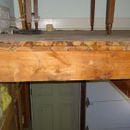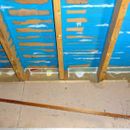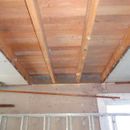Insulating tongue-and-groove floor over unconditioned garage
Hello. I’m a relatively inexperienced non-contractor attempting to correct a chronically cold floor (bonus room over garage) in my parent’s house. Dropping the garage ceiling revealed a poor previous cellulose job, blown into and around original fb batting (circa 1949). There was an air gap over most of the surface area between the insulation and subfloor.
Here’s the thing… it’s a tongue-and-groove finish floor over a tongue-and-groove subfloor. The history of air infiltration was evident in the blackened areas at the edges of the ceiling paneling and batting. I can only guess that the former was largely responsible for the latter; hence, a cold floor during winter.
There is also a poorly-weatherized staircase / door assembly ascending from the garage to the bonus room. While that is likely a contributing factor, I did an air-sealing test last winter which (I believe) rules it out as the sole factor.
I’ve been determined to correct the air leakage at the warm side (underside of the subfloor) rather than relying on a well-sealed drywall ceiling for the following reasons:
a) the structure is balloon-framed, meaning I’d have to add blocking to all the stud cavities along the side walls.
b) There will likely be penetrations to the drywall over time (hooks, etc.)… I mean, it’s a garage after all.
I made a fair attempt to avoid spray foam. A local insulation supplier was nice enough to offer me a 5-gallon pale of EcoSeal for cheap. (http://www.knaufinsulation.us/en/content/ecoseal-plus-sealant)
…with which to try sealing all the tongue-and-groove joints. Having hypothetically air-sealed the floor, the intent was to then fill the joist bays with Roxul (R23 – the joists are only 5.5″).
The results of spraying on the EcoSeal was less than ideal, possibly due to my inexperience with both the product as well as a pro paint sprayer (I’m quite sure the pressure was sufficient). Only the smallest tongue-and-groove gaps were successfully covered, leaving me to an almost futile task of touching up all the remaining gaps with caulk. I gave up halfway through, not knowing if what I was doing was even adequate.
I’ve about definitively given into the spray foam options; either flash & batt with 2″ closed-cell and 3.5″ batt, or 3″-3.5″ of closed-cell alone depending on code requirements.
So finally, the question:
What would you do in this situation??
I’m fending off advice from a number of local contractors, who invariably suggest ‘just throw some pink stuff up there’. Another one claims that the coldness issue is due to ‘radiant cold’ from insufficient insulation, but nothing to do with air leakage.
Sorry for the lengthy post. Any feedback appreciated.
Thanks, Dan
p.s. This is climate zone 5 (Buffalo, NY)
GBA Detail Library
A collection of one thousand construction details organized by climate and house part












Replies
Daniel,
Using spray foam to create an air barrier is a good approach. Open-cell spray foam is much more environmentally friendly than closed-cell spray foam. For more information on this topic, see Air Leakage Through Spray Polyurethane Foam.
If you don't want to use spray foam for budgetary or philosophical reasons, you can instead use the cut-and-cobble approach. Even 1 inch of rigid foam, installed tight to the subfloor and carefully sealed, should address the air sealing problem. The main disadvantages to this approach are (a) it's labor-intensive, and (b) it's often implemented imperfectly, resulting in some air leakage. For more information, see Cut-and-Cobble Insulation.
For an overview of your options, see How to Insulate a Cold Floor.